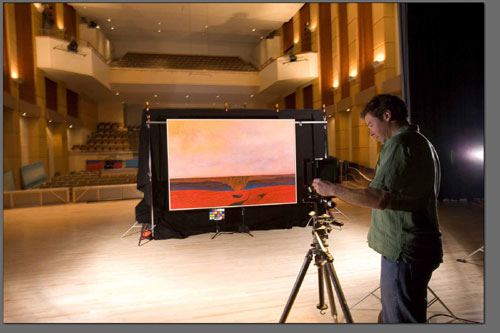|
| ||||
| Photographing Englehart
by Jules Masterjohn It was the middle of the afternoon, and the three of us were standing in front of Rifle Gap Falls, marveling at its majesty. It looked like a panorama of the primeval African mountains, the ones that may have birthed the earliest hominids, millions of years ago. Such beauty and expanse was not located in the headwaters of the Nile, however. This awe-inspiring vista was present on the stage of the Community Concert Hall at Fort Lewis College, in the form of pigment on canvas painted by local elder artist and Fort Lewis College Professor Emeritus Stanton Englehart. This very playhouse in which we stood, mouths agape in wonder at the colorful oil painting depicting Rifle Gap, Colo., was transformed into a temporary studio for the photographic documentation of Englehart’s paintings. In 1996, Englehart donated an 18-painting series of the Colorado Plateau to the college. This gift was part of a large monetary donation given by four generations of the Englehart-Porter family, all of whom had attended Fort Lewis College. The contributions kicked off the $5 million fund-raising campaign that made the Community Concert Hall possible. For a number of years now, most of these paintings, all 5-foot-by-8-foot horizontal landscapes, have hung in the concert hall building. Some are hung in public areas, and others are tucked into hallways and stairwells that comprise the facility. Others hang in the president’s office across campus. Through the efforts of the concert hall’s assistant director, Mary Floroplus, and the careful work of the FLC Physical Plant staff, all 18 paintings were removed from their many locations and placed inside the theater, leaning edge-to-edge, lining the walls. Technical Director Leann Brubaker readied the stage to be used as the two-day studio for photographer Scott DW Smith.
This planning was undertaken to facilitate the recording of the 18 paintings, never before professionally photographed, that are to be the centerpiece of a book being produced by the Durango Arts Center, documenting Englehart’s creative work. Photographer Smith was an ideal choice to for the project. Not only did Smith study with the artist at FLC, he has a careful eye and thorough technical ability to capture then painting’s subtle tonal variations. Englehart made Smith’s – or any photographer’s – task even more difficult by finishing all his oil paintings with a high gloss layer of varnish, making the paintings’ surfaces quite reflective. Mariah Mullins, Smith’s assistant, remarked that she had “never seen Scott as focused and intense” as he was the day of the shoot. His fastidiousness paid off. The photographic transparency images that resulted from the day’s effort were exact likenesses of the paintings. This series of paintings was conceived as a visual chronicle or “calendar” of landscapes of the Colorado Plateau, a constant theme in Englehart’s paintings. From Dinosaur and Great Sand Dunes national monuments, Mesa Verde and the San Juan Mountains to the Dolores River Valley, the artist circumnavigated Colorado, sketching the topographies that typified each region’s terrain. Englehart submitted 18 initial sketches as a mural proposal for the Denver Public Library, back in the early ’90s when the building was under construction. One of 400 artists who submitted proposals for the public art commission, Englehart and the others lost the competition to popular, nationally known artist Edward Ruscha. In spite of the rejection, and fortunately for our community, Englehart created the paintings anyway. These are not depictions of real locations but, rather, places filtered through the artist’s mind. Abstraction flirts with representation and realism in this series, which embodies many aspects of the artist’s painting styles. Strong compositional elements are characteristic of the suite: the horizon – of course – is the measure by which all other landscape elements are weighed, balancing right and left with the weight of the sky pulling up and the earth’s depths drawing down. It is common to see paintings that show Englehart’s signature coloration: pure red, blues and ochre pigments. In this series, and under the thorough illumination of Smith’s photographic lights, these paintings show some uncharacteristic colors: greens in shades of turquoise, olive and lime float in the clouded skies; purples of all hues, mauves and pinks are hidden in mountainous shadows. In “Rifle Gap Falls, Rifle, Colorado,” the palette is striking and unusual. There is a primordial feeling to the brewing and bubbling greens and oranges in the sky above the falls. Looking at it, one is aware of the overwhelming awe that ancient humans must have felt while witnessing a thunderstorm roll across the sky, angry with sound and light, possibly driving them into the safety of the earth’s nurturing cavities, protected. Englehart’s work speaks of the curiosity that motivated our ancient predecessors to journey beyond the safety of the cave, adventuring far and wide, to discover their world. Englehart, through this series of paintings, bravely and compassionately leads us to places that are deep and old in us, together venturing to the core of this condition we call “human.” •
|
In this week's issue...
- May 15, 2025
- End of the trail
Despite tariff pause, Colorado bike company can’t hang on through supply chain chaos
- May 8, 2025
- Shared pain
Dismal trend highlights need to cut usage in Upper Basin, too
- April 24, 2025
- A tale of two bills
Nuclear gets all the hype, but optimizing infrastructure will have bigger impact


